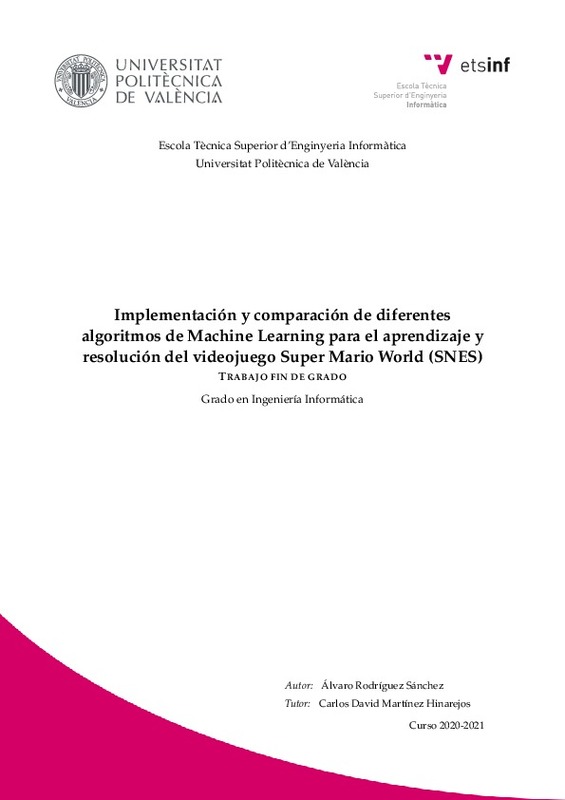JavaScript is disabled for your browser. Some features of this site may not work without it.
Buscar en RiuNet
Listar
Mi cuenta
Estadísticas
Ayuda RiuNet
Admin. UPV
Implementación y comparación de diferentes algoritmos de Machine Learning para el aprendizaje y resolución del videojuego Super Mario World (SNES)
Mostrar el registro sencillo del ítem
Ficheros en el ítem
| dc.contributor.advisor | Martínez Hinarejos, Carlos David
|
es_ES |
| dc.contributor.author | Rodríguez Sánchez, Álvaro
|
es_ES |
| dc.coverage.spatial | east=-0.4257591341644362; north=39.52077260645775; name=Passeig Penyal d'Ifach, 38, 46980 Paterna, Valencia, Espanya | es_ES |
| dc.date.accessioned | 2021-09-16T09:00:11Z | |
| dc.date.available | 2021-09-16T09:00:11Z | |
| dc.date.created | 2021-07-19 | |
| dc.date.issued | 2021-09-16 | es_ES |
| dc.identifier.uri | http://hdl.handle.net/10251/172613 | |
| dc.description.abstract | [ES] El objetivo del TFG propuesto es desarrollar e implementar dos algoritmos distintos basados en 'machine learning' en el videojuego Super Mario World de la consola Super Nintendo Entertaiment System (SNES), utilizando para ello la librería `gym-retro` que nos ofrece OpenAI en el lenguaje de programación Python. El primer algoritmo que será utilizado será un algoritmo evolutivo en el que se irá aprendiendo mediante una `fitness function¿ y la selección de las mejores muestras para crear el mejor jugador posible; este algoritmo será llevado acabo mediante NEAT-Python. El segundo algoritmo utilizado será un algoritmo de aprendizaje por refuerzo, en concreto Deep Q-Learning, que al ser aplicado a juegos de poca complejidad ha permitido obtener resultados prometedores. Finalmente se pasará a la comparación de los resultados obtenidos tras usar sendos algoritmos, pudiendo así demostrar cuál de los dos algoritmos resulta más interesante para la resolución de un juego de plataformas. | es_ES |
| dc.description.abstract | [EN] The objective of this end-of-degree project is to develop and implement two different algorithms based on Machine Learning for solving the Super Mario World video-game on the Super Nintendo Entertainment System (SNES) console, using the gym-retro library offered by OpenAI in the Python programming language. The first algorithm to be used Evolutionary Algorithm that will learn through a fitness function and the selection of the best samples to create the best possible player; this algorithm will be carried out using NEAT-Python. The second algorithm to be used will be a Reinforcement Learning algorithm, specifically Deep Q-Learning, which when it is applied to low-complexity games it has obtained promising results. Finally, we will proceed to the comparison of the re-sults obtained after using both algorithms, thus being able to show which of the two algorithms is more interesting for the resolution of a platform game. | es_ES |
| dc.description.abstract | [CA] L’objectiu del TFG proposat és desenvolupar i implementar dos algorismes diferents basats en machine learning en el videojoc Super Mario World de la consola Super Nintendo Entertaiment System (SNES), utilitzant per a això la llibreria gym-retro que ens ofereix OpenAI en el llenguatge de programació Python. El primer algorisme que serà utilitzat serà un algorisme evolutiu en què s’anirà aprenent mitjançant una fitness function i la selecció de les millors mostres per crear el millor jugador possible; aquest algorisme serà implementat mitjançant NEAT-Python. El segon algorisme utilitzat serà un algorisme d’aprenentatge per reforç, en concret Deep Q-Learning, que quan s’ha aplicat a jocs de poca complexitat ha obtingut resultats prometedors. Finalment, es passarà a la comparació dels resultats obtinguts després d’usar sengles algorismes, podent així demostrar quin dels dos algorismes resulta més interessant per a la resolució d’un joc de plataformes. | es_ES |
| dc.format.extent | 93 | es_ES |
| dc.language | Español | es_ES |
| dc.publisher | Universitat Politècnica de València | es_ES |
| dc.rights | Reconocimiento (by) | es_ES |
| dc.subject | Machine Learning | es_ES |
| dc.subject | Algoritmo evolutivo | es_ES |
| dc.subject | Aprendizaje por refuerzo | es_ES |
| dc.subject | OpenAI | es_ES |
| dc.subject | Videojuego | es_ES |
| dc.subject | Redes neuronales | es_ES |
| dc.subject | Evolutionary algorithm | es_ES |
| dc.subject | Reinforcement Learning | es_ES |
| dc.subject | Ope- nAI | es_ES |
| dc.subject | Videogame | es_ES |
| dc.subject | Mario Bros | es_ES |
| dc.subject | Nintendo | es_ES |
| dc.subject | Neural Networks | es_ES |
| dc.subject | DeepQ | es_ES |
| dc.subject.classification | LENGUAJES Y SISTEMAS INFORMATICOS | es_ES |
| dc.subject.other | Grado en Ingeniería Informática-Grau en Enginyeria Informàtica | es_ES |
| dc.title | Implementación y comparación de diferentes algoritmos de Machine Learning para el aprendizaje y resolución del videojuego Super Mario World (SNES) | es_ES |
| dc.type | Proyecto/Trabajo fin de carrera/grado | es_ES |
| dc.rights.accessRights | Abierto | es_ES |
| dc.contributor.affiliation | Universitat Politècnica de València. Departamento de Sistemas Informáticos y Computación - Departament de Sistemes Informàtics i Computació | es_ES |
| dc.contributor.affiliation | Universitat Politècnica de València. Escola Tècnica Superior d'Enginyeria Informàtica | es_ES |
| dc.description.bibliographicCitation | Rodríguez Sánchez, Á. (2021). Implementación y comparación de diferentes algoritmos de Machine Learning para el aprendizaje y resolución del videojuego Super Mario World (SNES). Universitat Politècnica de València. http://hdl.handle.net/10251/172613 | es_ES |
| dc.description.accrualMethod | TFGM | es_ES |
| dc.relation.pasarela | TFGM\141154 | es_ES |
Este ítem aparece en la(s) siguiente(s) colección(ones)
-
ETSINF - Trabajos académicos [5160]
Escola Tècnica Superior d'Enginyeria Informàtica






